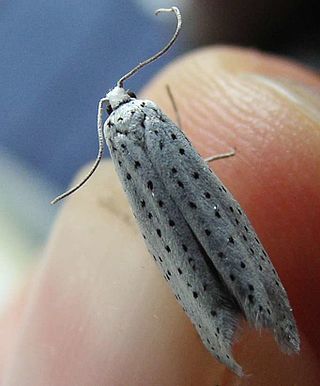
Yponomeutinae is a subfamily of "micromoths" in the lepidopteran family Yponomeutidae. As their scientific name implies, this is the subfamily containing the type genus of the ermine moths, Yponomeuta. The subfamily has worldwide distribution.

Elachista atricomella is a moth of the family Elachistidae that is found in Europe.

The lobster-clawed moth is a moth of the family Gelechiidae. It is found in most of Europe, except for the Iberian Peninsula and most of the Balkan Peninsula. In the east, the range extends to Siberia and Taiwan.

Lampronia corticella, the raspberry moth, is a moth of the family Prodoxidae. The species was first described by Carl Linnaeus in his 1758 10th edition of Systema Naturae. It is found in most of Europe, except Iceland, the Iberian Peninsula and the Balkan Peninsula. It is an introduced species in North America, where it was first detected in New Brunswick, Canada, in 1936.

Hellinsia didactylites is a moth of the family Pterophoridae. It is found in most of Europe, east into Russia.

Eudemis porphyrana is a moth of the family Tortricidae. It is found in most of Europe, east to the eastern part of the Palearctic realm.

Agonopterix astrantiae is a moth of the family Depressariidae. It is found in most of Europe, except the Iberian Peninsula, most of the Balkan Peninsula and the Benelux.

Depressaria olerella is a moth of the family Depressariidae. It is found in most of Europe, except Ireland, the Netherlands, the Iberian Peninsula and most of the Balkan Peninsula.
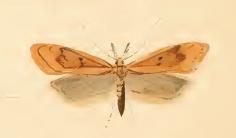
Dichomeris derasella is a moth of the family Gelechiidae. It is found in most of Europe, except Ireland, Norway, Sweden, the Iberian Peninsula and part of the Balkan Peninsula.

Dichomeris limosellus is a moth of the family Gelechiidae. It is found in most of Europe, except Ireland, Great Britain, Norway, the Iberian Peninsula and part of the Balkan Peninsula.
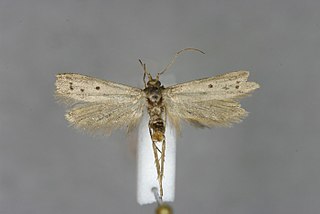
Hypatopa binotella, the spotted dowd moth, is a moth in the family Blastobasidae. It is found in most of mainland Europe, except the Iberian Peninsula and most of the Balkan Peninsula. It was first recorded from Great Britain in 2006 where it is probably accidentally imported.
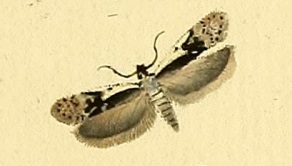
Anacampsis blattariella, the birch sober, is a moth of the family Gelechiidae. It is found in most of Europe, except Ireland, the Iberian Peninsula and most of the Balkan Peninsula.

Argolamprotes micella, the bright neb, is a moth of the family Gelechiidae. It is found in most of Europe, except Ireland, the Iberian Peninsula and most of the Balkan Peninsula. Outside of Europe, it is known from Siberia, the Russian Far East, the southern Kuril Islands and Japan. The habitat consists of hedgerows, open woodland and gardens.

Chionodes continuella is a moth of the family Gelechiidae. It is found from most of Europe, east to Japan. It is also present in most of North America.

Grapholita lobarzewskii, the appleseed moth, small fruit tortrix or smaller fruit tortrix moth, is a moth of the family Tortricidae. It was described by Maksymilian Nowicki in 1860. It is found in large parts of Europe, except Norway, Sweden, the Iberian Peninsula and most of the Balkan Peninsula.
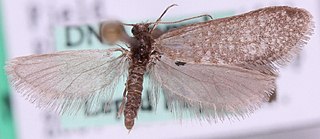
Siederia listerella is a moth of the Psychidae family. It was described by Carl Linnaeus in 1758. It is found in most of Europe, except Ireland, Great Britain, the Iberian Peninsula and most of the Balkan Peninsula.
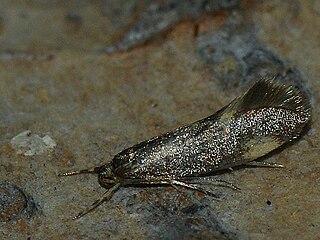
Metalampra cinnamomea is a moth of the family Oecophoridae. It was described by Philipp Christoph Zeller in 1839. It is found in most of Europe, except the Iberian Peninsula, most of the Balkan Peninsula, Ireland and Great Britain.
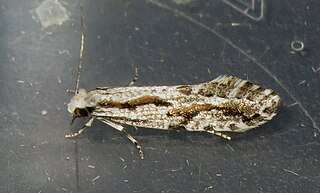
Archinemapogon yildizae is a moth of the family Tineidae. It was described by Ahmet Ömer Koçak in 1981. It is found in most of Europe, except Ireland, the Benelux, the Iberian Peninsula and most of the Balkan Peninsula. The habitat consists of birch woodlands.

Decantha borkhausenii is a moth of the family Oecophoridae. It is the type species of the genus Decantha, although it was once placed in the genus Oecophora. It is found in most of Europe, except Ireland, Great Britain, the Benelux, the Iberian Peninsula, most of the Balkan Peninsula, Denmark and Lithuania.

Triaxomera fulvimitrella, the four-spotted clothes moth, is a moth of the family Tineidae. It is found in most of Europe, except Ireland, the Iberian Peninsula, Italy, Slovenia and most of the Balkan Peninsula. The habitat consists of woodlands.
















